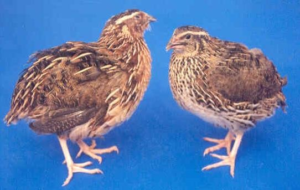Quail Farming: A Potential Enterprise for farmers
Sunita Didel1, Sunil Dutt1 and Sumit Karwa 2
1Ph.D. scholar, Division of Livestock Production Management,
2PhD Scholar, Division of Animal Genetics and Breeding,
ICAR-National Dairy Research Institute, Karnal (Haryana)
Corresponding author: Sunita Didel (sunitadidel123@gmail.com)
Abstract
Quail farming, known as “Bater” in Hindi, has emerged as a lucrative enterprise within the poultry industry, particularly in India. This endeavour offers numerous advantages, including minimal space requirements and low investment, making it accessible to both urban and rural settings. The Japanese quail, in particular, stands out for its rapid growth, high productivity, and early onset of egg production, providing a steady source of income for farmers. With various breeds available, such as the Black-breasted and Japanese quail, farmers have options to suit their specific needs and preferences. Housing design, feeding, breeding, and disease management are essential aspects of quail farming covered in this context. However, challenges such as male aggression towards females and the need for careful beak-trimming to prevent injuries during mating highlight the importance of effective management strategies. Despite these hurdles, quail farming presents a promising opportunity for poultry enthusiasts and entrepreneurs in India, contributing to the country’s agricultural and nutritional landscape while meeting the increasing demand for quality meat and eggs.
Keywords: Bater, Japanese quail, Quail farming
Introduction: –
Quail farming, known as “Bater” in Hindi, represents a lucrative enterprise within the poultry industry, particularly in India, where it is gaining traction due to its numerous benefits and high demand for its meat and eggs. The quail, a small to medium-sized game bird of the pheasant family, holds significant commercial potential, with two prominent species found in India the Black-breasted quail (Coturnix Coromandelica) and the Brown-coloured Japanese quail (Coturnix Coturnix Japonica). Of these, the Japanese quail is widely bred for meat production, offering a quick turnaround time for profitability. A broiler quail may be ready for sale at about five weeks, and quails begin producing eggs around six weeks of age. This early onset of egg production continues up to 24 weeks, ensuring a steady supply for commercial purposes. The Japanese quail, in particular, exhibits remarkable productivity, with adults weighing up to 250 grams and laying approximately 250 eggs per year. This efficiency in converting feed into animal protein makes quail farming an economically viable option. Quail meat is prized for its high protein content, essential fatty acids, and minerals such as sodium, potassium, and iron.In addition, quail eggs, weighing around 10 grameach, boast a higher proportion of yolk to albumen compared to chicken eggs, enhancing their nutritional profile. Quail farming requires smaller housing structures compared to traditional poultry farming, with approximately 10 quails occupying the space required for a single chicken. This makes it suitable for urban and backyard farming, optimizing land utilization. Quail farming traces its roots back to Japan, wherethe first domestication occurred in 1595., before spreading globally as a valuable source of protein. In India, quails were introduced in 1974 from California, with both indigenous and Japanese varieties finding favour among farmers for their adaptability and productivity. In conclusion, quail farming presents a promising avenue for poultry enthusiasts and entrepreneurs in India, offering a sustainable and profitable venture with minimal investment and space requirements. With its rapid growth, high productivity, and versatile uses, quail farming stands poised to meet the increasing demand for quality meat and eggs, contributing to the country’s agricultural and nutritional landscape.
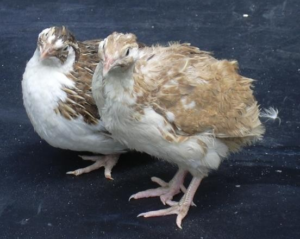
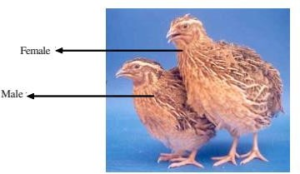
Japanese Quail Japanese Quail male and female birds
Advantage of quail farming
- Minimum Floor Space Requirement- Quail farming requires minimal floor space, making it suitable for both urban and rural settings where land availability may be limited.
- Low Investment: – Compared to other forms of livestock farming, quail farming requires relatively low investment, making it accessible to small-scale farmers and beginners.
- Sturdy Birds: Quails are known for their resilience and adaptability, making them comparatively sturdy and easier to manage than some other poultry breeds.
- Early Marketing: Quails can be marketed at an early age, typically around five weeks, allowing for quicker returns on investment.
- Early Sexual Maturity: Quails reach sexual maturity early, with females starting to lay eggs at around six to seven weeks of age, ensuring a rapid onset of egg production.
- High Egg Production: Quails exhibit a high rate of egg laying, with some breeds laying up to 280 eggs per year, providing a steady and lucrative source of income.
- Nutritious Meat and Eggs: Quail meat is known for its flavour and lower fat content than chicken, making it a better choice. Quail eggs are nutritionally similar to chicken eggs but contain less cholesterol, making them a popular choice among health-conscious customers.
- Ideal for Special Diets: Quail meat and eggs are extremely nutritious and especially useful to pregnant and nursing mothers improving both maternal and infant health.
- Ease of Rearing: Raising quails is relatively easy, even for beginners, as they require minimal care and management compared to larger poultry breeds.
- Profitable Business Opportunity: Commercial quail farming presents a profitable business idea, especially for educated unemployed youths seeking entrepreneurial opportunities. With low capital requirements and high demand for quail products, it offers a promising avenue for income generation and economic empowerment.
Breeds of Quails
In India, there are primarily two species of quail that are commonly recognized:
- Black-breasted Quail (Coturnix Coromandelica): Also known as the jungle quail, the black-breasted quail is native to India. It is found in jungle habitats and is known for its small size and distinctive black breast feathers in males. While not as commonly bred for commercial purposes, some people keep black-breasted quails for their ornamental value or as game birds.
- Japanese Quail (Coturnix Coturnix Japonica): The Japanese quail is widely bred for commercial purposes in India. It is prized for its high productivity, early sexual maturity, and adaptability to various environments. Japanese quails are raised primarily for their meat and eggs, with some strains laying up to 280 eggs per year. They are commonly found on commercial quail farms across India.These two species represent the main quail breeds found in India, each with its own unique characteristics and suitability for different purposes. While there may be variations within each species due to breeding programs and regional differences, these are the predominant quail breeds found in the country.
There are approximately 18 species of quail suitable for successful quail farming, each with its own unique characteristics and suitability for different purposes.
Here are all 18 species of quail suitable for successful quail farming:
- Tuxedo
- Pharaoh
- British Range
- English White
- Manchurian Golden
- Bobwhite (American)
- White Breasted (Indian)
- Black-breasted Quail (Coturnix Coromandelica)
- Japanese Quail (Coturnix Coturnix Japonica)
- CARI UTTAM (Broiler quail)
- CARI PEARL (Layer quail)
- CARI Brown
- CARI Ujjawal (White Breasted)
- CARI Sweta (White Feathered)
- CARI Sunheri (Brown Feather, White Breast)
- CARI Sunehari
- CARI BROWN (Brown Feathered Quail)
- CARI Pearl (White Egger)
These species offer a variety of characteristics and traits, allowing farmers to choose the most suitable breeds for their specific farming needs and preferences.
Layer breed
- Tuxedo
- Pharaoh
- British Range
- English White
- Manchurian Golden
Broiler breed
- Bobwhite (American)
- White Breasted (Indian)
Japanese quail and Bobwhite quail are domesticated varieties. Japanese quail are hardy, grows faster, has a short generation interval and is precocious.
Quail breeds developed by CARI
- CARI UTTAM (Broiler quail)- 220g
- CARI PEARL (layer quail)-290
- CARI brown 220
- CARI ujjawal (white breasted)
- CARI sweta (white feathered)
- CARI Sunheri (brown feather, white breast)
| Egg Type: CARI Pearl (White Egger)
· Body Weight at the 5th week: 140 g · Daily feed requirement: 20-25 g · Reaches 50% Egg Production by 8 weeks of age Reaches 80% Egg Production by 10 weeks of age – Expected hen day production ranges from 285 to 295 eggs. |
CARI Pearl |
| CARI Sunehari (Brown Feather White Breasted)
• Body Weight (straight-run) at the 5th week: 182 g • Age at sexual maturity: 43 days • Feed Conversion Ratio (FCR) at the 5th week: 2.8 • Average egg weight: 11g • Age at 50% Egg Production: 8 weeks • Age at peak Egg Production: 12-13 weeks |
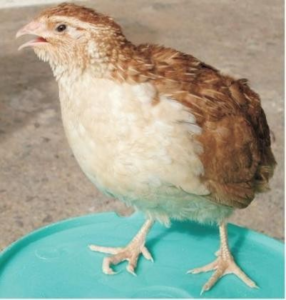
CARI Sunehari |
| CARI BROWN (Brown Feathered Quail)
• Weight at 5th week: 180-185 grams • Sexual maturity age: 38-41 days • Hatchability rate from total egg set: 60-65% • Plumage color: Solid brown |

CARI Brown |
| CARI Sweta (White Feathered Quail)
• Body Weight at the 5th week: 155-165 g • Daily feed intake: 25 g • Feed Conversion Ratio (FCR) at the 5th week: 2.70 • Hatchability on total egg set: 50-60% |

CARI Sweta |
| CARI Ujjawal (White Breasted Quail)
• Body weight at the 5th week: 175 g • Feed Conversion Ratio (FCR) at the 5th week: 2.80 • Daily feed intake: 25-28 g • Hatchability on total egg set: 65% |
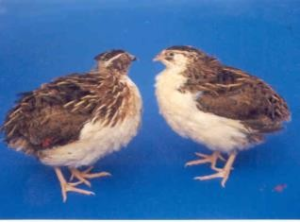
CARI Ujjwal |
| Meat Type CARI Uttam (Quail Broiler)
– Body weight at the 5th week: 240 g – Daily feed intake: 25-28 g – Feed Conversion Ratio (FCR) at the 5th week: 2.60 – Hatchability on total egg set: 70-75% |
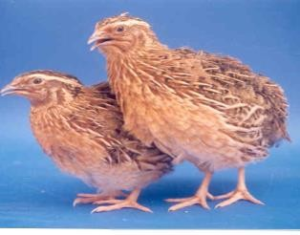
CARI Uttam |
Managing Housing for Quails
Quails, known for their ability to fly unlike chickens, are commonly reared in intensive systems due to the impracticality of free-range farming. In these systems, housing plays a crucial role in ensuring efficient management and optimal growth of quails.
Housing Design:
Quails can be successfully reared either on the floor or in specially designed cages. The use of battery brooders is typical for chicks up to three weeks old, after which they are transferred to growing cages. These growing cages, often referred to as colony or community cages, accommodate multiple birds and are utilized until the quails reach eight weeks of age. Subsequently, they are shifted to laying cages to facilitate egg production.
Battery Brooders

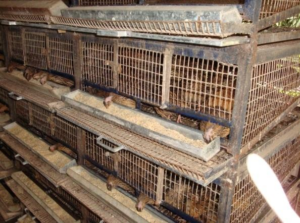
Quail Chicks in battery brooder Cage system of rearing
Battery brooders are structured in tiers, each measuring 160 cm x 80 cm with a height of 25 cm. These dimensions allow for the accommodation of 60 to 75 quail chicks per tier, providing them with adequate space for growth and development.
Growing Cages
Similar in design to battery brooders, growing cages lack a brooding area but maintain the same dimensions. Each tier of these colony growing cages can house 80 to 100 growing quails, ensuring efficient space utilization and management practices.
Laying Cages
Quails raised for laying purposes can be housed either in cages or on the floor. If cages are chosen, they can be tiered or of the Californian type. Each bird should be allotted 180 cm² of space. Waterers can be placed outside the cages or nipple waterers can be installed within the cages for automatic water supply.
Layer Quails in Cage

In cage systems, the cage floor should be slightly inclined to facilitate egg rolling out of the cage. A folded sleeve extending about 2.5 inches beyond the cage should be provided to catch the eggs. Japanese quails require 14-18 hours of light daily to sustain optimal egg production.
Space requirements of Japanese quail are tabulated below:
| Age(weeks) | Floorspace
(cm²/bird) |
Feeder space
(cm/bird) |
Drinker space
(cm/bird) |
| Up to 2 | 75 | 2.0 | 1.0 |
| 3 to 5 | 100 | 3.5 | 2.0 |
| 6 to 8 | 125 | 5.0 | 2.5 |
| 9andabove | 150 | 7.0 | 4.0 |
Feeding management in Quails: –
| Parameters | Starter/Grower
(0-6weeks) |
Breeder/Layer
(6weeksonwards) |
|
| Metabolizable energy, Kcal/kg | 2900 | 2900 | |
| Protein, % | 24.0 | 20.0 | |
| Lysine, % | 1.30 | 1.00 | |
| Methionine, % | 0.50 | 0.45 | |
| Calcium, % | 0.80 | 2.50 | |
| Available phosphorus, % | 0.30 | 0.35 | |
| Vitamin A, IU/kg | 1650 | 3300 | |
| Vitamin D, ICU/kg | 750 | 900 | |
| Vitamin E, mg/kg | 12 | 25 | |
| Riboflavin, mg/kg | 4 | 4 | |
| Source: NRC,1994 | |||
Feed material should be finely ground into small particles to facilitate consumption.
– At 5 weeks old, quails typically consume approximately 500 grams of feed.
– Quails aged 6 months consume around 30-35 grams of feed per day.
– Approximately 400 grams of feed is required for quails to produce 12 eggs.
– Broiler starter mash can be prepared by mixing 5 kilograms of oil cakes with 75 kilograms of feed. The feed should be ground again to reduce particle size before use.
Ensuring the proper provision of drinkers and feeders is crucial for the well-being of quails, as access to clean water and balanced nutrition significantly impacts their growth and productivity. To prevent drowning, small drinkers are necessary, and daily cleaning is essential to uphold hygiene standards and prevent bacterial contamination. Quails require a well-balanced and nutritious diet consisting of proteins, carbohydrates, vitamins, minerals, and fats to support their growth, egg production, and overall health. Similar to chickens, Japanese quails are commonly fed with a mix of raw materials. For chicks up to 6 weeks old, a broiler starter feed containing 24-28% protein is recommended, while older quails benefit from layer feed with 18-22% protein content. Despite their smaller size compared to larger poultry, quails have lower food requirements. They typically consume around 500 grams of feed up to four weeks of age. As adults, quails consume approximately 30 to 35 grams of feed per day, with around 400 grams of feed needed to produce a dozen eggs. Regular cleaning of feeders is crucial to prevent mold growth and ensure feed quality. Ideally, feeders should be cleaned weekly, and feed should be stored in a damp-free area to maintain its freshness. By the end of the 4th week, male quails usually weigh around 180-190 grams, while female quails reach weights of 190-210 grams, indicating their readiness for sale.
Breeding Management of quails
– Female quails are distinguished by their heavier weight and light brown feathers on theneck, while males exhibit brown feathers on the neck and under breast.
– Quails attain sexual maturity rapidly, with females initiating egg laying at 6 weeks and achieving 50% egg production by 8 weeks, maintaining high levels until 24 weeks.
– Optimal breeding ratios suggest 1 male to 3 females in deep litter systems and 1 male to 4 females in cages.
– Proper nesting boxes filled with soft bedding materials like straw or wood shavings are essential for egg laying.
– Each nesting box should measure 15 x 20 x 20 cm per 5 quails, with 4-5 boxes arranged in a row for comfort and security.
– Soft bedding cushions eggs, prevents breakage, and maintains optimal temperature and cleanliness.
– Regular cleaning and bedding replacement uphold hygiene and ensure quail well-being.
– Cage systems feature egg collecting channels for safe collection.
– Egg production hinges on temperature, feeding, water, care, and lighting.
– Lighting duration and intensity significantly impact egg laying, with a recommended schedule starting from 13 hours at 6 weeks and increasing to 16 hours by the 9th week.
– Quail eggs are aesthetically pleasing, weighing 7 to 15 grams, with Japanese quails capable of laying up to 290 to 300 eggs in their first year.
– Daily collection of eggs is crucial to maintain their quality and prevent issues such as dirtiness, cracking, or embryo development, particularly in hot weather where egg deterioration can be accelerated.
– Collecting eggs two to three times a day helps ensure optimal conditions and provides fresh, clean eggs, which enhances hatchability and produces high-quality chicks.
– Eggs weighing around 10 to 12 grams with hard and smooth eggshells are suitable for hatching and producing healthy chicks.
– Quails do not naturally incubate their eggs, so fertile quail eggs can be incubated using small-scale incubators or appropriately modified chicken hatcheries.
– The incubation period for quail eggs typically lasts 17-18 days, during which maintaining proper temperature and humidity levels is crucial for successful hatching.
Brooding management of Quails
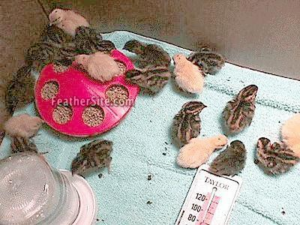 |
|
Brooding of quail on floor
Quail chicks, weighing approximately 7-9 grams at hatching, are highly fragile during their initial weeks of life, making them susceptible to temperature changes, humidity fluctuations, and stress. It typically takes about two weeks for them to develop enough strength and resilience to cope with environmental variations more effectively. Hence, providing optimal brooding conditions, including adequate temperature, lighting, air circulation, chick density, food and water supply, and hygienic rearing practices, is essential for their survival and early development. Brooding preparations involve meticulously cleaning and disinfecting the brooder house in advance, ensuring all four sides are enclosed with plastic sheets or screens up to the roof in both deep litter and cage rearing systems.
In the deep litter system, a circular brooder guard, constructed from cardboard or metallic sheets about 1 to 1.5 feet high, is set up with litter material such as paddy husks or wood shavings to a depth of approximately 2.5 cm. The litter is covered with newspaper or corrugated sheets to absorb moisture and droppings, which are changed daily. Electric bulbs are positioned in the center of the brooder guard, around 4 inches from the surface, to provide warmth, aiming for approximately 1 watt of heat per chick due to their small size. In the cage system, chicks are provided with a brooding facility for the first two weeks, ensuring a constant brooding temperature.
During the brooding period, maintaining a 24-hour lighting schedule is crucial. The temperature inside the brooder house is regulated, with temperatures set at 100°F during the first week, 95°F during the second week, and 90°F from the third week onwards. In case of power outages exceeding 2 hours, charcoal in earthen pots can help maintain the temperature inside the brooding house, with 3-4 earthen pots sufficient for 1000 chicks.
Provision of feed and water is vital, with broiler starter feed dispensed through semi-automatic circular feeders and fresh drinking water provided via semi-automatic drinkers. For chicks up to 2 weeks old, appropriate drinking and feeding space is ensured, with adjustments made as they grow older. Drinkers are carefully sized to prevent drowning, with the addition of pebbles to aid in this prevention. Adequate equipment, including drinkers and feeders, is provided based on chick numbers and age to ensure their nutritional needs are met effectively.
Egg Production in Japanese Quails:
Japanese quails reach maturity by 8 weeks of age, with peak egg production typically achieved between 13 to 15 weeks. Unlike chickens, Japanese quails lay eggs that constitute approximately 8% of their body weight, showcasing their high productivity in terms of egg production (Panda et al., 2019).
Characteristics of Japanese Quail Eggs:
– Weight: Japanese quail eggs weigh around 10 grams each, making them smaller in size compared to chicken eggs.
– Shell Appearance: The shells of Japanese quail eggs exhibit a highly mottled appearance, featuring dark colours of varying shades and shapes. Additionally, they have a distinctive mosaic pattern.
Quail Eggs
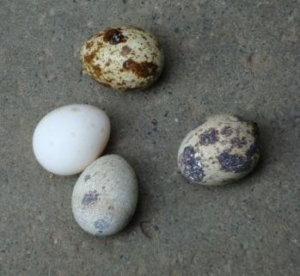
Shell Thickness: Japanese quail eggshells are notably thin, requiring careful handling during collection and storage to prevent breakage and damage.
– Egg Collection Frequency: It is recommended to collect quail eggs at least three times a day to maintain egg quality and hygiene standards.
Special Consideration:
– White Egg Producing Line: A specific breeding line has been developed to produce white-shelled eggs in Japanese quails, offering diversity in egg appearance and potentially catering to consumer preferences.
– Egg Size Variation: As Japanese quails age, there is typically an increase in egg size, reflecting variations in individual bird characteristics and reproductive maturity.
The timing of egg laying in Japanese quails predominantly occurs between 3 pm to 8 pm, highlighting their crepuscular nature. Careful management practices, including regular egg collection and attentive handling, are essential to optimize egg production and maintain quality standards in quail farming operations.
Disease management
- Japanese quails are naturally resilient to diseases and generally do not require multiple vaccinations like chickens, thriving in various climatic conditions.
- Despite their resilience, quails may sometimes be susceptible to diseases such as coccidiosis, brooder pneumonia, colibacillosis, and ulcerative enteritis.
- Coccidiosis, commonly affecting quails in deep litter systems, can be treated with Amprolium sulphate at a concentration of 1.00 g per litre of water for 3-5 days.
- Other bacterial diseases can be addressed with antibiotics such as Tetracycline, Streptomycin, or Amoxicillin, administered at a rate of 1 gram per litre of water for 3 to 5 days.
- Disease prevention relies heavily on good hygiene practices and regular cleaning of housing facilities. Proper disinfection of quail houses and cages is essential.
- Ensuring chicks are adequately warmed and protected from cold air during their early stages of life is crucial for disease prevention.
- Providing quality mixed feed and clean drinking water significantly reduces mortality rates in quails and helps protect them from diseases.
Hurdles in quail Farming
In quail farming, a distressing hurdle emerges when the natural behaviour of male quails disturbs the well-being of females. When housed together, male quails may exhibit aggressive behaviour towards females, often pecking them. This aggression can escalate to the point where females become blind due to repeated pecking. Unfortunately, this physical harm leads to a cascade of negative consequences for the affected females and the overall productivity of the flock. As a result of their injuries, blind females experience a decrease in their feed intake, impacting both their health and productivity. This reduction in feed consumption ultimately results in decreased egg production and bodyweight gain among the afflicted females. Consequently, this hurdle not only causes suffering to the quails but also poses significant challenges to the economic viability of quail farming operations, requiring careful management strategies to mitigate aggression and prevent such detrimental outcomes.
Beak trimming in quails
Beak-trimming in quails follows a procedure akin to that of chickens, typically conducted when the birds reach 3 weeks of age. However, due to the smaller size of quails and the increased difficulty in handling them compared to chickens, extra care is necessary during this process.
Beak-trimming holds particular significance in quail farming because, during mating, males may inadvertently inflict severe injuries on females if their beaks are not properly trimmed. Hence, ensuring that the procedure is carried out meticulously is essential for the well-being and safety of the quail flock.
Legal issues in Quail farming
Legal issues in quail farming have been a significant hurdle, particularly regarding the regulatory framework governing their farming practices. Initially, Japanese Quail (J. Quail) was protected under wildlife legislation until 1972. However, despite recognition of its potential for commercial farming, obtaining licenses for commercial quail farming was a cumbersome process. In 1997, the delegation of licensing authority to Veterinary Assistants (VAS) and Assistant Livestock Officers aimed to streamline the process. Nonetheless, legal problems and harassment persisted, impeding the industry’s progress. These issues included challenges in obtaining licenses, compliance with regulations, and addressing conflicts with wildlife protection laws. Consequently, to alleviate these hurdles and facilitate the growth of quail farming, Japanese Quail was removed from the coverage of the Wildlife Act on December 6, 2013. This legal amendment liberated quail farming from wildlife protection regulations, enabling it to be treated similarly to other poultry birds. Despite this positive step, ongoing legal challenges may still arise, necessitating continued vigilance and advocacy to ensure a conducive legal environment for quail farming.
Conclusions
Quail farming presents a promising opportunity in the agricultural landscape, offering numerous benefits including low start-up costs, efficient feed conversion, and versatile market potential. Despite facing hurdles such as regulatory challenges, predation, and disease management, quail farming continues to gain traction as a viable enterprise. With advancements in technology and management practices, the industry is poised for growth and innovation. The removal of legal barriers, such as the inclusion of quail under wildlife protection acts, has further bolstered its potential for expansion. As demand for sustainable protein sources rises, quail farming stands ready to meet this need while providing economic opportunities for farmers. With careful attention to best practices and ongoing support, quail farming holds promise for a prosperous and sustainable future in agriculture.
References:
- Panda, A.K., Ramachandran, R., & Sridhar, K. (2019). Quail Production Systems. In: Panda, A.K., Ramachandran, R., & Sridhar, K. (Eds.), Quail Farming: Markets, Management, and Diseases (pp. 1-22). Academic Press.
- Panda, A.K., Ramachandran, R., & Sridhar, K. (Eds.). (2019). Quail Farming: Markets, Management, and Diseases. Academic Press.
- National Research Council (NRC). (1994). Nutrient Requirements of Poultry. National Academies Press.
- Panda, A.K., & Ramachandran, R. (2021). Sustainable Livestock Production Systems. CRC Press.
- Sridhar, K., Panda, A.K., & Ramachandran, R. (2020). Poultry Farming: Principles and Practices. Springer.
- Ministry of Agriculture and Farmers Welfare, Government of India. (n.d.). National Portal of India: Quail Farming. Retrieved from [URL]



